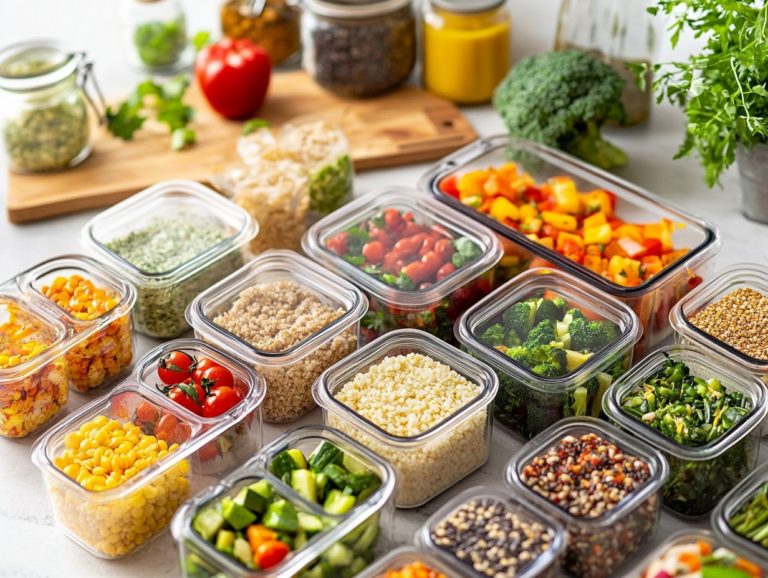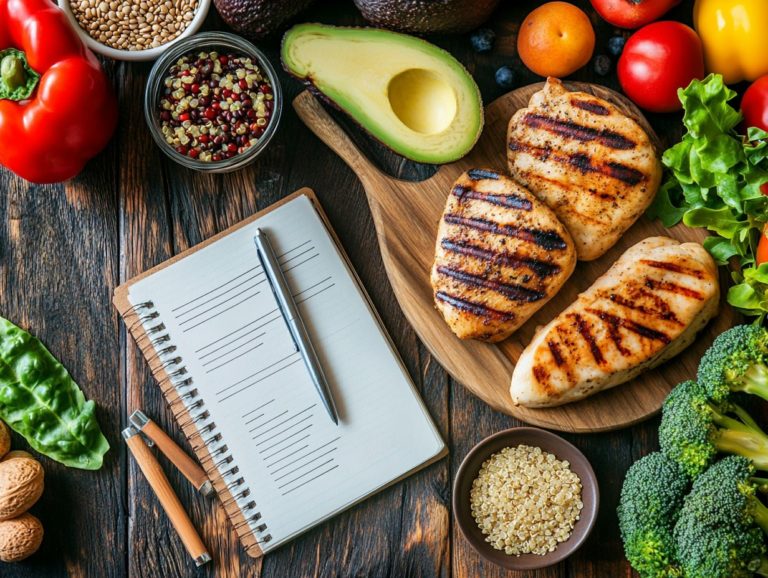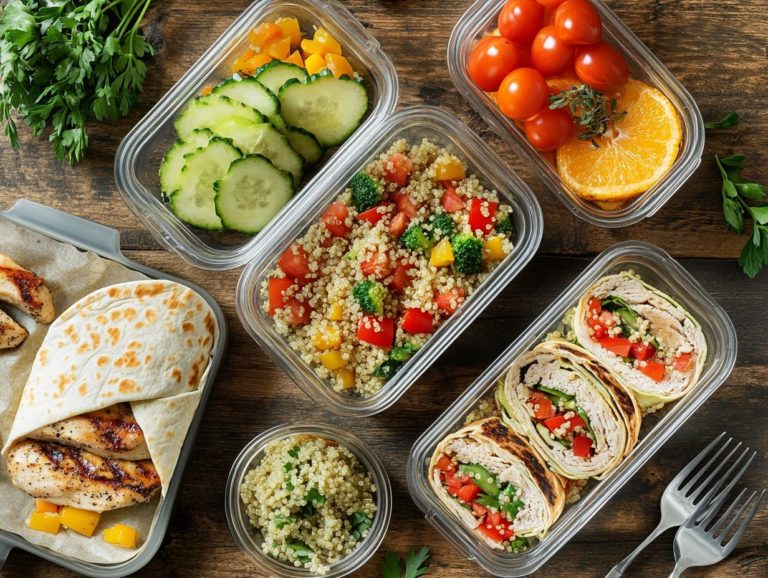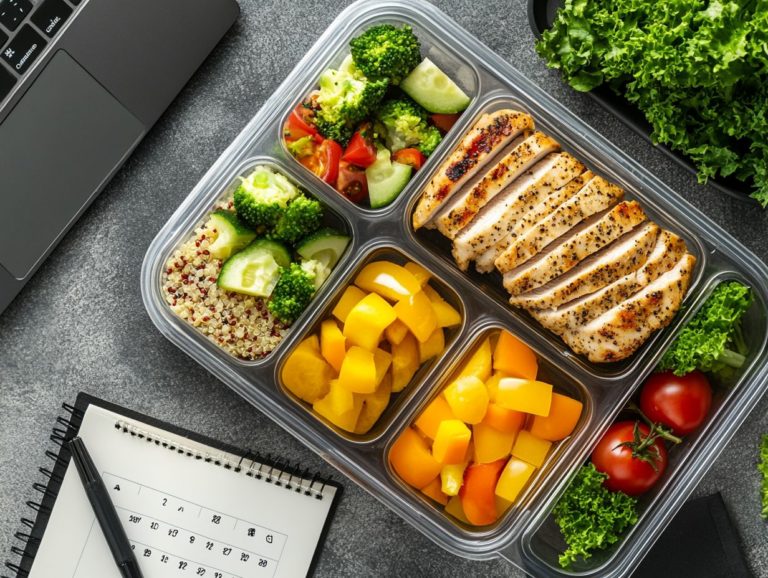Meal Planning for Healthy Eating on a Budget
Meal planning is a key tool for anyone looking to eat healthily and save money.
With a solid meal plan, you can boost your nutrition while cutting down on food waste.
This guide will help you create a meal plan that meets your needs.
From budgeting tips to accommodating dietary restrictions, discover how meal planning transforms your lifestyle.
Contents
- Key Takeaways:
- The Importance of Meal Planning
- Steps to Create a Meal Plan
- Healthy Eating on a Budget
- Meal Planning for Different Dietary Restrictions
- Meal Prep and Batch Cooking
- Frequently Asked Questions
- What is meal planning for healthy eating on a budget?
- Why is meal planning important for healthy eating on a budget?
- How do I start meal planning for healthy eating on a budget?
- What are some budget-friendly ingredients for healthy eating?
- Can I still eat healthy on a budget without sacrificing taste?
- How can I save money while grocery shopping for healthy meals?
Key Takeaways:

- Meal planning is essential for maintaining a healthy diet and staying within budget. It helps identify what your body needs to stay healthy while allowing for efficient budgeting and shopping strategies.
- Choosing nutritious and affordable foods is possible with mindful meal planning. Buying in-season produce and opting for plant-based protein sources can help maintain a healthy diet while saving money.
- Meal prep and batch cooking save you time and money. By preparing meals in advance, you can avoid impulse purchases and reduce food waste, ultimately helping you stick to a budget.
The Importance of Meal Planning
Meal planning is an essential practice that elevates your healthy eating game while positively influencing your food budget, especially when you consider weekly meal planning on a budget.
By thoughtfully organizing your meals in advance, you can ensure that you include nutritious ingredients, minimize food waste, and make savvy shopping choices.
Experts like Victoria Seaver and Christa Brown highlight that a well-crafted meal plan fosters healthier choices and supports a more sustainable lifestyle.
This approach not only saves you time throughout the week but also opens the door to a variety of affordable options, making it simpler to sustain a heart-healthy diet without breaking the bank.
Benefits for Health and Budget
Meal planning does more than save time; it boosts your health and keeps your budget in check!
By prioritizing nutritious meals, you can make intentional choices that align with your dietary needs while seizing cost-saving opportunities.
With a well-structured meal plan, you can effortlessly incorporate a variety of fruits, vegetables, whole grains, and lean proteins into your diet, ensuring you get the nutrients you need.
For instance, whipping up vibrant salads or hearty grain bowls can be done at a fraction of the cost of dining out plus, you gain the added advantage of controlling portion sizes and selecting your ingredients.
Understanding food science enables you to explore cooking techniques that enhance flavor while preserving nutrition, like steaming or roasting.
By adopting budget-friendly cooking strategies, such as bulk cooking or leveraging seasonal produce, the true effectiveness of meal planning in promoting a balanced diet becomes strikingly clear.
Steps to Create a Meal Plan
Creating an effective meal plan entails a series of strategic steps designed to enhance your cooking experience while supporting healthy choices, such as meal planning for a vegan lifestyle, and managing your budget.
By assessing your nutritional needs and thoughtfully crafting a shopping list, you set the stage for success in your meal planning journey.
Each step you take is integral to achieving a seamless and enjoyable culinary endeavor.
Identifying Nutritional Needs and Preferences

Identifying your nutritional needs and preferences is a crucial first step toward creating a successful meal plan.
Consulting with a registered dietitian, a food and nutrition expert, can equip you with essential nutrition education tailored to your unique requirements.
To effectively evaluate your dietary needs, consider various factors such as your age, activity level, and any existing health conditions.
For instance, younger adults may need more protein for muscle development, while older adults should focus on calcium and vitamin D for maintaining strong bones.
An active individual will have distinct caloric and nutrient requirements compared to someone with a more sedentary lifestyle.
Incorporating the expertise of a registered dietitian can be invaluable in crafting a balanced meal plan that caters to these specific needs.
For example, if you’re managing diabetes, a well-structured meal plan can prioritize high-fiber foods and regulate carbohydrate intake to help optimize blood sugar levels.
Understanding these crucial aspects of nutrition is vital for promoting lasting health and wellness.
Budgeting and Shopping Strategies
Smart budgeting and shopping can make meal planning fun! Effective strategies can help you discover the benefits of meal planning for health while whipping up nutritious meals without breaking the bank.
By crafting a detailed shopping list and seizing grocery deals, you can stretch your budget while stocking up on important pantry staples.
To elevate your budgeting game, consider techniques like the envelope system, where you earmark a specific amount for grocery expenses, or utilize mobile apps tailored for expense tracking.
Identifying cost-saving grocery deals can optimize your financial approach; for example, checking local flyers for discounts can lead to substantial savings.
Creating a shopping list based on your meal plan ensures that you don t overlook any essentials while keeping those pesky impulse buys at bay.
And remember to include versatile pantry staples like grains, legumes, and spices they re the backbone of budget-friendly cooking, capable of transforming simple ingredients into mouthwatering meals.
Healthy Eating on a Budget
Eating healthy on a budget is not just possible it’s an exciting challenge waiting for you!
By prioritizing affordable ingredients that enhance nutrition, you can craft meals that nourish both body and taste buds.
With a few savvy cooking tips and a willingness to explore various options, you’ll find that satisfying and cost-effective meals are well within your grasp.
Tips for Choosing Nutritious and Affordable Foods
Choosing nutritious and affordable foods demands a strategic mindset. Pick fresh fruits, vegetables, and affordable staples like canned beans.
By honing in on these essentials, you can craft meals that are not only healthy but also easy on the wallet.
Choose seasonal fruits and vegetables like strawberries in summer or pumpkin in fall for fresh flavors and low prices.
Regarding plant-based proteins like lentils, chickpeas, and quinoa, opting for bulk options can drastically reduce your costs.
Canned beans, a true pantry hero, offer a wonderful way to introduce protein and fiber into your meals without straining your budget.
Their versatility makes them ideal for everything from salads to soups or stir-fries.
By planning your meals around what’s on sale or in season, you can make healthier choices that respect your budget while enjoying a diverse and nutritionally sound diet. For more guidance, consider checking out these meal planning tips for healthy snacking.
Meal Planning for Different Dietary Restrictions

Meal planning for different dietary needs can be a fun challenge that sparks creativity!
By thoughtfully adapting your meal plan, you can ensure that everyone’s nutritional requirements are met, all while maintaining a delightful balance of flavor and satisfaction.
Vegetarian, Vegan, and Gluten-Free Options
When meal planning for those with dietary restrictions, include a variety of vegetarian, vegan, and gluten-free recipes. This will meet nutritional needs and tantalize taste buds.
Use legumes like lentils and chickpeas. They are high in protein and add a hearty touch to salads, stews, or grain bowls.
Quinoa and brown rice are excellent gluten-free grains. They serve as a vibrant base for stir-fries or veggie burgers.
If you lean toward a vegan lifestyle, incorporate nuts and seeds. Chia seeds in smoothies or almonds for snacking can boost protein without losing flavor.
Simple techniques like roasting vegetables with olive oil can enhance natural flavors. This makes every meal nutritious and satisfying.
Meal Prep and Batch Cooking
Meal prep and batch cooking save time and ensure nutritious meals are available for busy lifestyles. Preparing meals in advance simplifies cooking, minimizes food waste, and aligns with nutrition goals.
Efficient Strategies for Saving Time and Money
Implement time-saving strategies in meal preparation to enhance your cooking experience. These practices promote budget-friendly methods and reduce food waste.
Select seasonal and locally sourced ingredients. This elevates freshness and supports sustainable practices.
Embrace batch cooking. Prepare generous portions of grains, proteins, and vegetables for easy meal combinations throughout the week.
For food storage, use airtight containers to keep leftovers fresh. Label them with dates to avoid waste.
Get creative with leftovers. Transform roasted vegetables into soup or add excess grains to salads. This contributes to an efficient kitchen routine.
Frequently Asked Questions

What is meal planning for healthy eating on a budget?
The idea of meal planning is to prepare and organize meals in advance while considering your budget. This includes selecting budget-friendly ingredients and recipes.
Why is meal planning important for healthy eating on a budget?
Meal planning helps you make informed decisions about meals. It ensures you choose nutritious options while reducing food waste and saving money.
How do I start meal planning for healthy eating on a budget?
To begin, assess your budget for groceries and list your go-to budget-friendly ingredients. Create a weekly meal plan that incorporates these items.
What are some budget-friendly ingredients for healthy eating?
Budget-friendly ingredients include canned or frozen fruits and vegetables, whole grains like brown rice and quinoa, lean proteins like beans and chicken, and healthy fats like avocado and olive oil.
Can I still eat healthy on a budget without sacrificing taste?
Yes, you can eat healthy and stay within your budget! Many tasty and affordable recipes use simple ingredients like spices and herbs to elevate your meals.
Get creative! Try new recipes to keep your meals exciting and enjoyable.
How can I save money while grocery shopping for healthy meals?
To save money, start by making a grocery list and stick to it. Avoid unnecessary items and choose generic or store brands for better savings.
Buy in bulk and plan meals around sales. Check for coupons and use loyalty cards to maximize your savings!
Start your budget-friendly meal planning today and enjoy delicious, healthy food!






